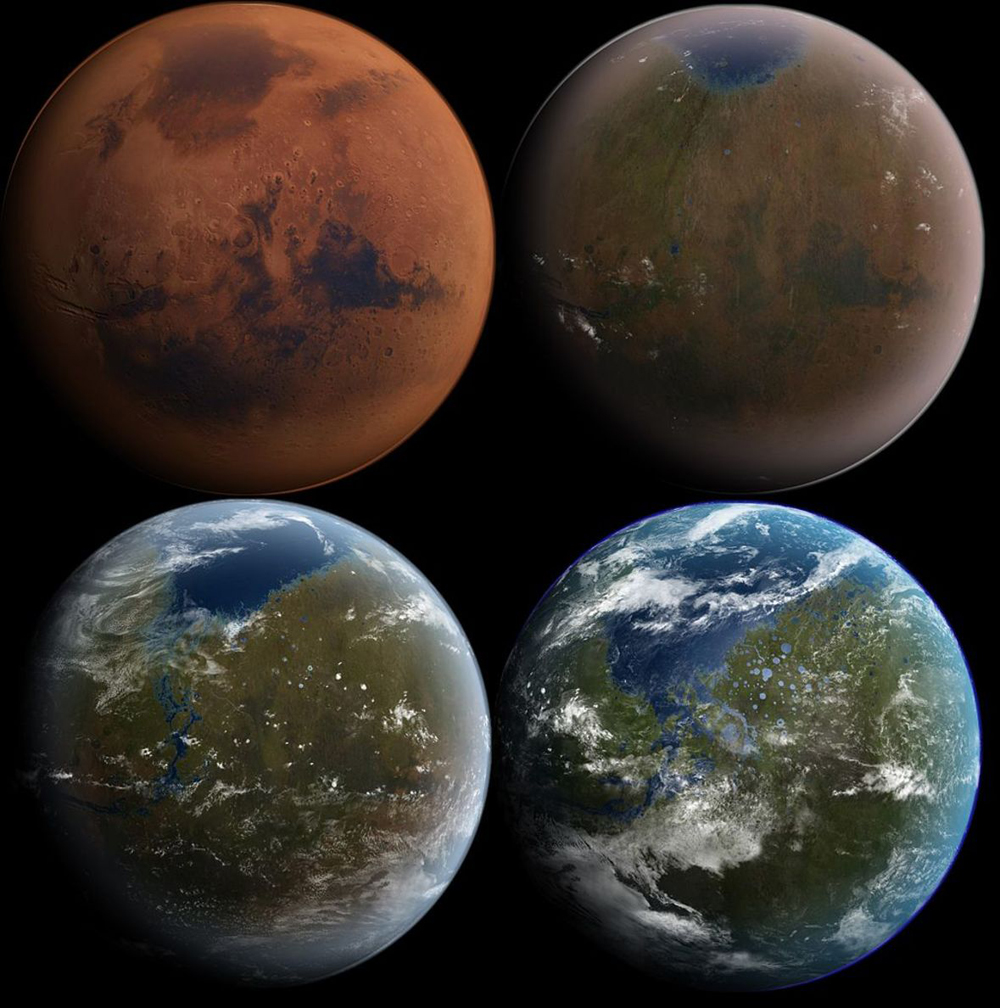
Elon Musk seems serious about nuking Mars.
SpaceX's billionaire founder and CEO teased the idea in 2015 during an appearance on "The Late Show with Stephen Colbert," explaining that vaporizing Mars' ice caps would be a good way to warm the planet enough for human colonists to live relatively comfortably.
Musk floated the concept again last week via Twitter, initially saying simply "Nuke Mars!" and then "T-shirt soon."
Related: Make Mars Livable with Asteroids: A Terraforming Plan
Nuke Mars refers to a continuous stream of very low fallout nuclear fusion explosions above the atmosphere to create artificial suns. Much like our sun, this would not cause Mars to become radioactive.August 20, 2019
Well, the T-shirt has now arrived, as have more of Musk's Mars-nuking thoughts.
"Nuke Mars refers to a continuous stream of very low fallout nuclear fusion explosions above the atmosphere to create artificial suns. Much like our sun, this would not cause Mars to become radioactive," the entrepreneur tweeted yesterday (Aug. 20).
"Not risky imo & can be adjusted/improved real-time. Essentially need to figure out most effective way to convert mass to energy, as Mars is slightly too far from this solar system's fusion reactor (the sun)," he added in another tweet, responding to someone who asked about the risks associated with this terraforming plan.
Get the Space.com Newsletter
Breaking space news, the latest updates on rocket launches, skywatching events and more!
Indeed, Musk engaged his followers in significant discussion about the idea, as he frequently does on Twitter. For example, somebody suggested employing "solar dirigible airships" on the Red Planet to increase solar-power and heat generation. "Trickier than it may seem on Mars, as atmospheric density is 1% that of Earth & gravity is 38%, but doable for localized warming," Musk responded.
Astrophysicist and YouTube personality Scott Manley suggested diverting a few comets to impact the Martian poles, which sparked aerospace veteran Dennis Wingo to tweet, "Why does everyone always think that diverting comets is easy?"
Then Musk weighed in: "True, diverting a comet would be super hard. Could be done with small asteroids & a mass driver, but this is risky."
True, diverting a comet would be super hard. Could be done with small asteroids & a mass driver, but this is risky.August 20, 2019
Musk aims to help humanity colonize Mars; he has stressed repeatedly that he started SpaceX in 2002 primarily with this long-term goal in mind. And the company is now developing a spaceflight system to make it all happen: a 100-passenger spacecraft called Starship and a huge rocket called Super Heavy.
The reusable duo could start operational launches as early as 2021 and begin flying people by 2023, SpaceX representatives have said. If everything goes well, crewed Mars missions could lift off sometime in the 2020s.
Musk's terraforming thoughts may have evolved by then. Actually, they may shift dramatically in the next few days, if another one of yesterday's tweets is any guide.
"Might make sense to have thousands of solar reflector satellites to warm Mars vs artificial suns (tbd)," Musk wrote.
- Shell-Worlds: How Humanity Could Terraform Small Planets (Infographic)
- Gallery: Starship and Super Heavy: SpaceX's Mars-Colonizing Vehicles
- SpaceX's Mars Colony Plan: How Elon Musk Plans to Build a Million-Person Martian City
Mike Wall's book about the search for alien life, "Out There" (Grand Central Publishing, 2018; illustrated by Karl Tate), is out now. Follow him on Twitter @michaeldwall. Follow us on Twitter @Spacedotcom or Facebook.
Join our Space Forums to keep talking space on the latest missions, night sky and more! And if you have a news tip, correction or comment, let us know at: community@space.com.

Michael Wall is a Senior Space Writer with Space.com and joined the team in 2010. He primarily covers exoplanets, spaceflight and military space, but has been known to dabble in the space art beat. His book about the search for alien life, "Out There," was published on Nov. 13, 2018. Before becoming a science writer, Michael worked as a herpetologist and wildlife biologist. He has a Ph.D. in evolutionary biology from the University of Sydney, Australia, a bachelor's degree from the University of Arizona, and a graduate certificate in science writing from the University of California, Santa Cruz. To find out what his latest project is, you can follow Michael on Twitter.









